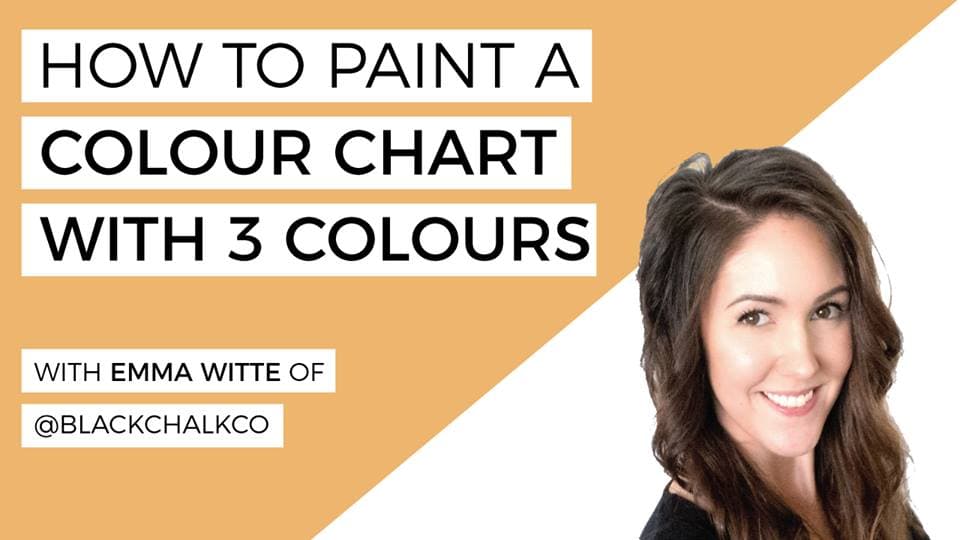I was so excited when Emma Witte of Black Chalk Collective, who just so happens to be my VERY FIRST live interviewee agreed to come back on The Happy Ever Crafters Facebook group for a live watercolour lesson.
The first time Emma came around, she showed us how to turn your lettering passion into a business. This time she showed us how to create a watercolour colour chart using ONLY 3 COLOURS!!
Emma is brilliant when it comes to watercolours. Not only does she teach Palettiquette, a monthly watercolour school, she is now MAKING HER OWN WATERCOLOURS!! Seriously! You can check out her beautiful handmade watercolour at The Watercolour Factory.
You can watch the lesson below and follow along here, or head on over to my YouTube channel, The Happy Ever Crafter!
The links below may be affiliate links where appropriate. This means that your purchase through these links may result in a few cents in payment to me, to support creating further resources like this one! That being said, I will never suggest supplies that I do not personally use and fully recommend.
Now, let’s learn how to create a colour chart using only 3 colours!
You might be wondering, what is the point of a colour chart?
- So you can see the all of the possibilities you can create with just 3 colours
- To use as a cross-reference tool for creating colours again and again
Next, you’ll need some supplies.
Tools:
Paper – Any cold press paper will do!
Pencil, eraser and ruler to draw your chart (details bellow)
Washi Tape (Optional) – As dividers between each box
Primary Colours: Red, Yellow, Blue
Mixing palettes – Emma uses two old plate!
Brush – Round of flat brush, (Emma is using a round size 8)
Paper Towels
Water
In case you’re unfamiliar, primary colours are the three pure colours which, when mixed, will create secondary colours, so so on and so forth.
Primary (Pure) Colours:
Red
Yellow
Blue
Secondary Colours:
Orange (Red + Yellow)
Green (Yellow + Blue)
Purple (Blue + Red)
Okay, I tried really hard to type out the steps for this blog post, but in true honesty, watching the video will be muuuch easier to understand.
Emma does a wonderful job explaining and SHOWING her process (all while explaining why she does the steps the way she does, which is super important) so if you’re finding my steps a little lacking, Emma’s video is the place to go!
Step One: Prep your Paper
- Draw your chart – 11.5 cm X 11.5 cm (1 cm boxes with 0.5 cm spacing in between)
- Chart down the colours in order: Yellow, Orange, Red, Violet, Blue, Green
- Keep a “dominant side” consisting of 75% to 25% ratios
Step Two: Prep your colours
- Make large colour puddles using the primary colours
- Mix medium colour puddles of secondary colours
Step Three: Fill ‘Er Up!
- Fill in the diagonal colours where the primary colours meet themselves first. (By this I mean: Red + Red, Blue + Blue, Yellow + Yellow)
- Secondary colours will be mixed at a 50% to 50% ratio
Useful Tips:
- When you mix colours, it is best to mix the darker pigmented colour into the lighter colour and not the other way around!
- If you want to make a colour lighter, dilute it with water!
- Keep in mind, the colours down the diagonal line will be muuuch more saturated than the other colours on the chart, simply because they will be more saturated (and the other colours will have more water mixed into them!)
- Rinse your paintbrushes in two different water jars. One for warm tones and another for cool tones. This will keep your water from getting too mucky.
- In the video, Emma is using a round brush. If you want to keep your lines really clean, a flat brush would be helpful!
- You don’t need to spend a fortune on many colours! The whole point of learning colour theory is to understand how colours are made, so that you can purchase 3 high quality artist paints instead of multiple student grade paints.
If you’d like to learn more from Emma, you have to check out Palettiquette!
You can snag the Colour Theory 101 course FOR FREE as well as any of the other 14 courses available, with new ones added monthly.
While you’re at it, take a look at her Insta account, where she shares most of her work, and give her a follow!

Comments